Trumpet
This articleneeds additional citations forverification.(October 2019) |
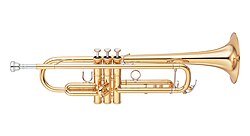 Trumpet in B♭ | |
| Brass instrument | |
|---|---|
| Classification | |
| Hornbostel–Sachs classification | 423.233 (Valvedaerophonesounded by lip vibration) |
| Playing range | |
 | |
| Related instruments | |
| flugelhorn,cornet,cornett,flumpet,bugle,natural trumpet,bass trumpet,post horn,Roman tuba,buccina,cornu,lituus,shofar,dord,dung chen,sringa,shankha,lur,didgeridoo,alphorn,Russian horns,serpent,ophicleide,piccolo trumpet,horn,alto horn,baritone horn,pocket trumpet | |
| Part of a series on |
| Musical instruments |
|---|
Thetrumpetis abrass instrumentcommonly used in classical andjazzensembles.The trumpet group ranges from thepiccolo trumpet—with the highestregisterin the brass family—to thebass trumpet,pitched one octave below the standard B♭or C trumpet.
Trumpet-like instruments have historically been used as signaling devices in battle or hunting, with examples dating back to at least 2000 BC.[1]They began to be used as musical instruments only in the late 14th or early 15th century.[2]Trumpets are used inart musicstyles, for instance in orchestras,concert bands,andjazzensembles, as well as inpopular music.Sound is produced by vibrating the lips in a mouthpiece,[3]which starts astanding wavein the air column of the instrument. Since the late 15th century, trumpets have primarily been constructed ofbrasstubing, usually bent twice into a rounded rectangular shape.
There are many distinct types of trumpet, with the most common being pitched in B♭(atransposing instrument), having a tubing length of about 1.48 m (4 ft 10 in). Early trumpets did not provide means to change the length of tubing, whereas modern instruments generally have three (or sometimes four)valvesin order to change theirpitch.Most trumpets have valves of thepistontype, while some have therotarytype. The use of rotary-valved trumpets is more common in orchestral settings (especially in German and German-style orchestras), although this practice varies by country. A musician who plays the trumpet is called atrumpet playerortrumpeter.[4]
Etymology
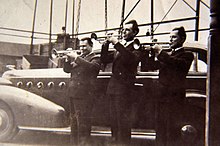
The English wordtrumpetwas first used in the late 14th century.[5]The word came from Old Frenchtrompette,which is a diminutive oftrompe.[5]The wordtrump,meaningtrumpet,was first used in English in 1300. The word comes from Old Frenchtrompe'long, tube-like musical wind instrument' (12c.), cognate with Provençaltromba,Italiantromba,all probably from a Germanic source (compare Old High Germantrumpa,Old Norsetrumba'trumpet'), of imitative origin. "[6]
History


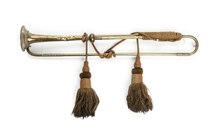
The earliest trumpets date back to 2000 BC and earlier. The bronze and silverTutankhamun's trumpetsfrom his grave in Egypt,bronze lursfrom Scandinavia, and metal trumpets from China date back to this period.[7]Trumpets from theOxuscivilization (3rd millennium BC) of Central Asia have decorated swellings in the middle, yet are made out of one sheet of metal, which is considered a technical wonder for its time.[8]
TheSalpinxwas a straight trumpet 62 inches (1,600 mm) long, made of bone or bronze.Homer’sIliad(9th or 8th century BCE) contain the earliest reference to its sound and further, frequent descriptions are found throughout theClassical Period.[9]Salpinx contests were a part of the original Olympic Games.[10]TheShofar,made from a ram horn and the Hatzotzeroth, made of metal, are both mentioned in the Bible. They were said to have been played in Solomon's Temple around 3,000 years ago. They are still used on certain religious days.[10]
TheMochepeople of ancientPerudepicted trumpets in their art going back to AD 300.[11]The earliest trumpets were signaling instruments used for military or religious purposes, rather than music in the modern sense;[12]and the modernbuglecontinues this signaling tradition.

Improvements to instrument design and metal making in the late Middle Ages and Renaissance led to an increased usefulness of the trumpet as a musical instrument. Thenatural trumpetsof this era consisted of a single coiled tube without valves and therefore could only produce the notes of a single overtone series. Changing keys required the player to changecrooksof the instrument.[10]The development of the upper, "clarino"register by specialist trumpeters—notablyCesare Bendinelli—would lend itself well to theBaroqueera, also known as the "Golden Age of the natural trumpet." During this period, a vast body of music was written for virtuoso trumpeters. The art was revived in the mid-20th century and natural trumpet playing is again a thriving art around the world. Many modern players in Germany and the UK who perform Baroque music use a version of the natural trumpet fitted with three or four vent holes to aid in correcting out-of-tune notes in the harmonic series.[13]
The melody-dominatedhomophonyof theclassicaland romantic periods relegated the trumpet to a secondary role by most major composers owing to the limitations of the natural trumpet.Berliozwrote in 1844:
Notwithstanding the real loftiness and distinguished nature of its quality of tone, there are few instruments that have been more degraded (than the trumpet). Down toBeethovenandWeber,every composer – not exceptingMozart– persisted in confining it to the unworthy function of filling up, or in causing it to sound two or three commonplace rhythmical formulae.[14]
Construction

The trumpet is constructed ofbrasstubing bent twice into a rounded oblong shape.[15]As with all brass instruments, sound is produced by blowing air through slightly separated lips, producing a "buzzing" sound into themouthpieceand starting astanding wavevibration in the air column inside the trumpet. The player can select thepitchfrom a range ofovertonesorharmonicsby changing the lipapertureand tension (known as theembouchure).
The mouthpiece has a circular rim, which provides a comfortable environment for the lips' vibration. Directly behind the rim is the cup, which channels the air into a much smaller opening (the back bore or shank) that tapers out slightly to match the diameter of the trumpet's lead pipe. The dimensions of these parts of the mouthpiece affect thetimbreor quality of sound, the ease of playability, and player comfort. Generally, the wider and deeper the cup, the darker the sound and timbre.

Modern trumpets have three (or, infrequently, four)piston valves,each of which increases the length of tubing when engaged, thereby lowering the pitch. The first valve lowers the instrument's pitch by a whole step (twosemitones), the second valve by a half step (one semitone), and the third valve by one and a half steps (three semitones). Having three valves provides eight possible valve combinations (including "none" ), but only seven different tubing lengths, because the third valve alone gives essentially the same tubing length as the 1–2 combination. (In practice there is often a deliberately designed slight difference between "1–2" and "3", and in that case trumpet players will select the alternative that gives the best tuning for the particular note being played.) When a fourth valve is present, as with somepiccolo trumpets,it usually lowers the pitch aperfect fourth(five semitones). Used singly and in combination these valves make the instrument fullychromatic,i.e., able to play all twelve pitches of classical music. For more information about the different types of valves, seeBrass instrument valves.
The overall pitch of the trumpet can be raised or lowered by the use of the tuning slide. Pulling the slide out lowers the pitch; pushing the slide in raises it. Pitch can be "bent" using the embouchure only.[16]
To overcome the problems of intonation and reduce the use of the slides,Renold Schilkedesigned the tuning-bell trumpet. Removing the usual brace between the bell and a valve body allows the use of a sliding bell; the player may then tune the horn with the bell while leaving the slide pushed in, or nearly so, thereby improving intonation and overall response.[17]
A trumpet becomes aclosed tubewhen the player presses it to the lips; therefore, the instrument only naturally produces every other overtone of the harmonic series. The shape of the bell makes the missing overtones audible.[18]Most notes in the series are slightly out of tune and modern trumpets have slide mechanisms for the first and third valves with which the player can compensate bythrowing(extending) or retracting one or both slides, using the left thumb and ring finger for the first and third valve slides respectively.
Trumpets can be constructed from other materials, including plastic.[19]
Types


The most common type is the B♭trumpet, but A, C, D, E♭,E, low F, and G trumpets are also available. The C trumpet is most common in American orchestral playing, where it is used alongside the B♭trumpet.Orchestraltrumpet players are adept at transposing music at sight, frequently playing music written for the A, B♭,D, E♭,E, or F trumpet on the C trumpet or B♭trumpet.

The smallest trumpets are referred to aspiccolo trumpets.The most common models are built to play in both B♭and A, with separate leadpipes for each key. The tubing in the B♭piccolo trumpet is one-half the length of that in a standard B♭trumpet making it sound an octave higher. Piccolo trumpets in G, F and C are also manufactured, but are less common. Almost all piccolo trumpets have four valves instead of three—the fourth valve usually lowers the pitch by a fourth, making some lower notes accessible and creating alternate fingerings for certaintrills.Maurice André,Håkan Hardenberger,David Mason,andWynton Marsalisare some well-known trumpet players known for their virtuosity on the piccolo trumpet.
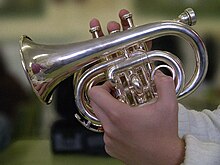

Trumpets pitched in the key of low G are also called sopranos, or soprano bugles, after their adaptation from militarybugles.Traditionally used indrum and bugle corps,sopranos employ eitherrotary valvesorpiston valves.
The bass trumpet is at the same pitch as a trombone and is usually played by a trombone player,[4]although its music is written intreble clef.Most bass trumpets are pitched in either C or B♭.The C bass trumpet sounds anoctavelower than written, and the B♭bass sounds a major ninth (B♭) lower, making them bothtransposing instruments.
The historical slide trumpet was probably first developed in the late 14th century for use inalta cappellawind bands. Deriving from early straight trumpets, the Renaissance slide trumpet was essentially a natural trumpet with a sliding leadpipe. This single slide was awkward, as the entire instrument moved, and the range of the slide was probably no more than a major third. Originals were probably pitched in D, to fit withshawmsin D and G, probably at a typical pitch standard near A=466 Hz. No known instruments from this period survive, so the details—and even the existence—of a Renaissance slide trumpet is a matter of debate among scholars. While there is documentation (written and artistic) of its existence, there is also conjecture that its slide would have been impractical.[20]
Some slide trumpet designs saw use in England in the 18th century.[21]
Thepocket trumpetis a compact B♭trumpet. The bell is usually smaller than a standard trumpet bell and the tubing is more tightly wound to reduce the instrument size without reducing the total tube length. Its design is not standardized, and the quality of various models varies greatly. It can have a unique warm sound and voice-like articulation. Since many pocket trumpet models suffer from poor design as well as poor manufacturing, the intonation, tone color and dynamic range of such instruments are severely hindered. Professional-standard instruments are, however, available. While they are not a substitute for the full-sized instrument, they can be useful in certain contexts. The jazz musicianDon Cherrywas renowned for his playing of the pocket instrument.
The tubing of the bell section of aherald trumpetis straight, making it long enough to accommodate a hanging banner. This instrument is mostly used for ceremonial events such as parades andfanfares.
David Monettedesigned theflumpetin 1989 for jazz musicianArt Farmer.It is a hybrid of a trumpet and a flugelhorn, pitched in B♭and using three piston valves.[22]
Other variations includerotary-valve,or German, trumpets (which are commonly used in professional German and Austrian orchestras), alto andBaroque trumpets,and theVienna valvetrumpet (primarily used in Viennese brass ensembles and orchestras such as theVienna PhilharmonicandMnozil Brass).
The trumpet is often confused with its close relative thecornet,which has a moreconicaltubing shape compared to the trumpet's morecylindricaltube. This, along with additional bends in the cornet's tubing, gives the cornet a slightly mellower tone, but the instruments are otherwise nearly identical. They have the same length of tubing and, therefore, the same pitch, so music written for one of them is playable on the other. Another relative, theflugelhorn,has tubing that is even more conical than that of the cornet, and an even mellower tone. It is sometimes supplied with a fourth valve to improve the intonation of some lower notes.
Playing
Fingering
On any modern trumpet, cornet, or flugelhorn, pressing the valves indicated by the numbers below produces the written notes shown. "Open" means all valves up, "1" means first valve, "1–2" means first and second valve simultaneously, and so on. The sounding pitch depends on the transposition of the instrument. Engaging the fourth valve, if present, usually drops any of these pitches by aperfect fourthas well. Within eachovertoneseries, the different pitches are attained by changing theembouchure.Standard fingerings above high C are the same as for the notes an octave below (C♯is 1–2, D is 1, etc.).

Eachovertoneseries on the trumpet begins with the first overtone—thefundamentalof each overtone series cannot be produced except as apedal tone.Notes in parentheses are the sixth overtone, representing a pitch with a frequency of seven times that of the fundamental; while this pitch is close to the note shown, it is flat relative toequal temperament,and use of those fingerings is generally avoided.
The fingering schema arises from the length of each valve's tubing (a longer tube produces a lower pitch). Valve "1" increases the tubing length enough to lower the pitch by one whole step, valve "2" by one half step, and valve "3" by one and a half steps.[23]This scheme and the nature of the overtone series create the possibility of alternate fingerings for certain notes. For example, third-space "C" can be produced with no valves engaged (standard fingering) or with valves 2–3. Also, any note produced with 1–2 as its standard fingering can also be produced with valve 3 – each drops the pitch by1+1⁄2steps. Alternate fingerings may be used to improve facility in certain passages, or to aid in intonation. Extending the third valve slide when using the fingerings 1–3 or 1-2-3 further lowers the pitch slightly to improve intonation.[24]
Some of the partials of theharmonic seriesthat a modern B♭trumpet can play for each combination of valves pressed are in tune with12-tone equal temperamentand some are not.[25]
Mutes

Various types of mutes can be placed in or over the bell, which decreases volume and changes timbre.[26]Of all brass instruments, trumpets have the widest selection of mutes: common mutes include thestraight mute,cup mute,harmon mute(wah-wah or wow-wow mute, among other names[27]),plunger,bucket mute,andpractice mute.[28]When the type of mute is not specified, players generally use a straight mute, the most common type.[27]Jazz, commercial, and show band musicians often use a wider range of mutes than their classical counterparts,[26]and many mutes were invented for jazz orchestrators.[29]
Mutes can be made of many materials, including fiberglass, plastic, cardboard, metal, and "stone lining", a trade name of the Humes & Berg company.[30]They are often held in place with cork.[26][31]To better keep the mute in place, players sometimes dampen the cork by blowing warm, moist air on it.[26]
The straight mute is conical and constructed of either metal (usually aluminum[27])—which produces a bright, piercing sound—or another material, which produces a darker, stuffier sound.[32][33]The cup mute is shaped like a straight mute with an additional, bell-facing cup at the end, and produces a darker tone than a straight mute.[34]The harmon mute is made of metal (usually aluminum or copper[27]) and consists of a "stem" inserted into a large chamber.[34]The stem can be extended or removed to produce different timbres, and waving one's hand in front of the mute produces a "wah-wah" sound, hence the mute's colloquial name.[34]
Range
Using standard technique, the lowest note is the written F♯belowmiddle C.[citation needed]There is no actual limit to how high brass instruments can play, but fingering charts generally go up to thehigh Ctwo octaves above middle C. Several trumpeters have achieved fame for their proficiency in the extreme high register, among themMaynard Ferguson,Cat Anderson,Dizzy Gillespie,Doc Severinsen,and more recentlyWayne Bergeron,Louis Dowdeswell,Thomas Gansch,James Morrison,Jon FaddisandArturo Sandoval.It is also possible to producepedal tonesbelow the low F♯,which is a device occasionally employed in the contemporary repertoire for the instrument.
Extended technique
Contemporary music for the trumpet makes wide uses of extended trumpet techniques.
Flutter tonguing:The trumpeter rolls the tip of the tongue (as if rolling an "R" in Spanish) to produce a 'growling like' tone. This technique is widely employed by composers likeBerioandStockhausen.
Growling:Simultaneously playing tone and using the back of the tongue to vibrate the uvula, creating a distinct sound. Most trumpet players will use a plunger with this technique to achieve a particular sound heard in a lot of Chicago Jazz of the 1950s.
Double tonguing:The player articulates using the syllablesta-ka ta-ka ta-ka.
Triple tonguing:The same as double tonguing, but with the syllablesta-ta-ka ta-ta-ka ta-ta-ka.
Doodle tongue:The trumpeter tongues as if saying the worddoodle.This is a very faint tonguing similar in sound to a valve tremolo.
Glissando:Trumpeters can slide between notes by depressing the valves halfway and changing the lip tension. Modern repertoire makes extensive use of this technique.
Vibrato:It is often regulated in contemporary repertoire through specific notation. Composers can call for everything from fast, slow or no vibrato to actual rhythmic patterns played with vibrato.
Pedal tone:Composers have written notes as low as two-and-a-half octaves below the low F♯at the bottom of the standard range. Extreme low pedals are produced by slipping the lower lip out of the mouthpiece.Claude Gordonassigned pedals as part of his trumpet practice routines, that were a systematic expansion on his lessons with Herbert L. Clarke. The technique was pioneered byBohumir Kryl.[35]
Microtones:Composers such as Scelsi and Stockhausen have made wide use of the trumpet's ability to play microtonally. Some instruments feature a fourth valve that provides a quarter-tone step between each note. The jazz musicianIbrahim Maaloufuses such a trumpet, invented by his father to make it possible to playArab maqams.
Valve tremolo:Many notes on the trumpet can be played in several different valve combinations. By alternating between valve combinations on the same note, a tremolo effect can be created. Berio makes extended use of this technique in hisSequenza X.
Noises:By hissing, clicking, or breathing through the instrument, the trumpet can be made to resonate in ways that do not sound at all like a trumpet. Noises may require amplification.
Preparation:Composers have called for trumpeters to play under water, or with certain slides removed. It is increasingly common for composers to specify all sorts of preparations for trumpet. Extreme preparations involve alternate constructions, such as double bells and extra valves.
Split tone:Trumpeters can produce more than one tone simultaneously by vibrating the two lips at different speeds. The interval produced is usually an octave or a fifth.
Lip-trill or shake:Also known as "lip-slurs". By rapidly varying air speed, but not changing the depressed valves, the pitch can vary quickly between adjacent harmonic partials. Shakes and lip-trills can vary in speed, and in the distance between the partials. However, lip-trills and shakes usually involve the next partial up from the written note.
Multi-phonics:Playing a note and "humming" a different note simultaneously. For example, sustaining a middle C and humming a major 3rd "E" at the same time.
Circular breathing:A technique wind players use to produce uninterrupted tone, without pauses for breaths. The player puffs up the cheeks, storing air, then breathes in rapidly through the nose while using the cheeks to continue pushing air outwards.
Instruction and method books
One trumpet method isJean-Baptiste Arban'sComplete Conservatory Method for Trumpet (Cornet).[36]Other well-known method books includeTechnical StudiesbyHerbert L. Clarke,[37]Grand Methodby Louis Saint-Jacome,Daily Drills and Technical StudiesbyMax Schlossberg,and methods byErnest S. Williams,Claude Gordon,Charles Colin,James Stamp,and Louis Davidson.[38]A common method book for beginners is the Walter Beeler'sMethod for the Cornet,and there have been several instruction books written by virtuosoAllen Vizzutti.[39]Merri Franquinwrote aComplete Method for Modern Trumpet,[40]which fell into obscurity for much of the twentieth century until public endorsements byMaurice Andrérevived interest in this work.[41]
Players
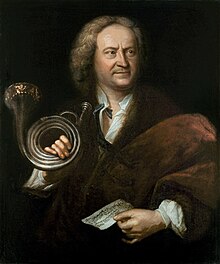
In early jazz,Louis Armstrongwas well known for his virtuosity and his improvisations on theHot FiveandHot Sevenrecordings, and his switch fromcornetto trumpet is often cited as heralding the trumpet's dominance over the cornet in jazz.[4][42]Dizzy Gillespiewas a giftedimproviserwith an extremely high (but musical) range, building on the style ofRoy Eldridgebut adding new layers ofharmoniccomplexity. Gillespie had an enormous impact on virtually every subsequent trumpeter, both by the example of his playing and as a mentor to younger musicians.Miles Davisis widely considered one of the most influential musicians of the 20th century—his style was distinctive and widely imitated. Davis' phrasing and sense of space in his solos have been models for generations of jazz musicians.[43]Cat Andersonwas a trumpet player who was known for the ability to play extremely high with an even more extreme volume, who played with Duke Ellington's Big Band.Maynard Fergusoncame to prominence playing inStan Kenton's orchestra, before forming his own band in 1957. He was noted for being able to play accurately in a remarkably highregister.[44]
Musical pieces
Solos
Anton Weidingerdeveloped in the 1790s the first successfulkeyed trumpet,capable of playing all the chromatic notes in its range.Joseph Haydn'sTrumpet Concertowas written for him in 1796 and startled contemporary audiences by its novelty,[45]a fact shown off by some stepwise melodies played low in the instrument's range.
In art
-
The Last Judgment (workshop of Hieronymus Bosch),c. 1500–1510
-
Trumpet-Player in front of a Banquet,Gerrit Dou,c. 1660–1665
-
Illustration forThe Trumpeter Taken PrisonerfromBaby's Own Aesop,a children's edition ofAesop's fables
-
Louis Armstrongstatue inAlgiers, New Orleans
-
Miles Davisstatue inKielce, Poland
See also
References
Notes
- ^White, H.N. (25 June 2023)."History of the Trumpet and Cornet".Trumpet-history.com.Retrieved25 June2023.
- ^ "History of the Trumpet (According to theNew Harvard Dictionary of Music) ".petrouska.com. Archived fromthe originalon 8 June 2008.Retrieved17 December2014.
- ^"Brass Family of Instruments: What instruments are in the Brass Family?".www.orsymphony.org.Retrieved12 May2020.
- ^abcKoehler 2013
- ^ab"Trumpet".www.etymonline.com.Online Etymology Dictionary.Retrieved20 May2017.
- ^"Trump".www.etymonline.com.Online Etymology Dictionary.Retrieved20 May2017.
- ^Edward Tarr,The Trumpet(Portland, Oregon: Amadeus Press, 1988), 20–30.
- ^"Trumpet with a swelling decorated with a human head,"Musée du Louvre
- ^Homer,Iliad,18. 219.
- ^abc"History of the Trumpet | Pops' Trumpet College".Bbtrumpet.com.8 November 2017.Retrieved19 April2021.
- ^Berrin, Katherine & Larco Museum.The Spirit of Ancient Peru:Treasures from theMuseo Arqueológico Rafael Larco Herrera.New York:Thames and Hudson,1997.
- ^ "Chicago Symphony Orchestra – Glossary – Brass instruments".cso.org.Retrieved3 May2008.
- ^John Wallace and Alexander McGrattan,The Trumpet,Yale Musical Instrument Series (New Haven and London: Yale University Press, 2011): 239.ISBN978-0-300-11230-6.
- ^Berlioz, Hector(1844).Treatise on modern Instrumentation and Orchestration.Edwin F. Kalmus,NY, 1948.
- ^ "Trumpet, Brass Instrument".dsokids.com.Retrieved3 May2008.
- ^Blackwell, James (11 December 2012)."Pitch Bends!".Blackwells Trumpet Basics.Retrieved26 June2023.
- ^Bloch, Dr. Colin (August 1978)."The Bell-Tuned Trumpet".Archived fromthe originalon 25 December 2008.Retrieved25 February2010.
- ^D. J. Blaikley, "How a Trumpet Is Made. I. The Natural Trumpet and Horn",The Musical Times,1 January 1910, p. 15.
- ^P-trumpet
- ^ "IngentaConnect More about Renaissance slide trumpets: fact or fiction?".ingentaconnect.com. Archived fromthe originalon 22 September 2012.Retrieved3 May2008.
- ^ Lessen, Martin (1997). "JSTOR: Notes, Second Series".Notes.54(2): 484–485.doi:10.2307/899543.JSTOR899543.
- ^Koehler, Elisa (2014).Fanfares and Finesse: A Performer's Guide to Trumpet History and Literature.Indiana University Press. p. 55.ISBN978-0-253-01179-4.Retrieved7 December2017.
- ^Pagliaro, Michael J. (2016).The Brass Instrument Owner's Handbook.Lanham, Maryland:Rowman & Littlefield.pp. 37–39.ISBN978-1-4422-6862-3.OCLC946032345.
- ^Ely, Mark C.; Van Deuren, Amy E. (2009).Wind Talk for Brass: A Practical Guide to Understanding and Teaching Brass Instruments.Amy E. Van Deuren. Oxford:Oxford University Press.pp. 8–12.ISBN978-0-19-971631-9.OCLC472461178.
- ^Schafer, Erika."Trumpet Tuning Tendencies Relating to the Overtone Series with Solutions".UTC Trumpet Studio.Retrieved19 January2023.
- ^abcdEly 2009,p. 109.
- ^abcdEly 2009,p. 111.
- ^For the "widest selection of mutes", seeSevsay 2013,p. 125.
- For the list of common mutes, seeEly 2009,p. 109.
- ^Boyden, David D.; Bevan, Clifford; Page, Janet K. (20 January 2001)."Mute".Grove Music Online.doi:10.1093/gmo/9781561592630.article.19478.ISBN978-1-56159-263-0.Retrieved16 September2020.
- ^For the list of materials, seeEly 2009,p. 109.
- For the origin of "stonelined mutes", seeKoehler 2013,p. 173.
- ^Sevsay 2013,p. 125.
- ^Sevsay 2013,p. 125: "plastic (fiberglass): not as forceful as the metal mute, a bit darker in color, but still penetrating"
- ^Koehler 2013,p. 173.
- ^abcSevsay 2013,p. 126.
- ^Joseph Wheeler, "Review: Edward H. Tarr,Die Trompete"The Galpin Society Journal,Vol. 31, May 1978, p. 167.
- ^Arban, Jean-Baptiste(1894, 1936, 1982).Arban's Complete Conservatory Method for trumpet.Carl Fischer, Inc.ISBN0-8258-0385-3.
- ^Herbert L. Clarke(1984).Technical Studies for the Cornet,C. Carl Fischer, Inc.ISBN0-8258-0158-3.
- ^Colin, Charles andAdvanced Lip Flexibilities.[full citation needed]
- ^"Allen Vizzutti Official Website".www.vizzutti.com.Retrieved21 October2016.
- ^Franquin, Merri (2016) [1908]. Quinlan, Timothy (ed.)."Complete Method for Modern Trumpet".qpress.ca.Translated by Jackson, Susie.
- ^Shamu, Geoffrey."Merri Franquin and His Contribution to the Art of Trumpet Playing"(PDF).p. 20.Retrieved11 August2017.
- ^West, Michael J. (3 November 2017)."The Cornet: Secrets of the Little Big Horn".JazzTimes.com.Retrieved17 August2018.
- ^ "Miles Davis, Trumpeter, Dies; Jazz Genius, 65, Defined Cool".nytimes.com.Retrieved3 May2008.
- ^"Ferguson, Maynard".Encyclopedia of Music in Canada.The Canadian Encyclopedia.Retrieved2 January2008.
- ^Keith Anderson, liner notes for Naxos CD 8.550243,Famous Trumpet Concertos,"Haydn's concerto, written for Weidinger in 1796, must have. At the first performance of the new concerto in Vienna in 1800 a trumpet melody was heard in a lower register than had hitherto been practicable."
Bibliography
- Barclay, R. L. (1992).The art of the trumpet-maker: the materials, tools, and techniques of the seventeenth [sic] and eighteenth centuries in Nuremberg.Oxford [England]: Clarendon Press.ISBN0-19-816223-5.
- Bate, Philip (1978).The trumpet and trombone: an outline of their history, development, and construction(2nd ed.). London: E. Benn.ISBN0-393-02129-7.
- Brownlow, James Arthur (1996).The last trumpet: a history of the English slide trumpet.Stuyvesant, N.Y.: Pendragon Press.ISBN0-945193-81-5.
- Campos, Frank Gabriel (2005).Trumpet technique.Oxford: Oxford University Press.ISBN0-19-516692-2.
- Cassone, Gabriele (2009).The trumpet book(1st ed.). Varese, Italy: Zecchini.ISBN978-88-87203-80-6.
- Ely, Mark C. (2009).Wind talk for brass: a practical guide to understanding and teaching brass instruments.Oxford: Oxford University Press.ISBN978-0-19-532924-7.
- English, Betty Lou (1980).You can't be timid with a trumpet: notes from the orchestra(1st ed.). New York: Lothrop, Lee & Shepard Books.ISBN0-688-41963-1.
- Koehler, Elisa (2013).Dictionary for the modern trumpet player.Lanham, Maryland: Scarecrow Press.ISBN978-0-8108-8658-2.
- Sherman, Roger (1979).The trumpeter's handbook: a comprehensive guide to playing and teaching the trumpet.Athens, Ohio: Accura Music.ISBN0-918194-02-4.
- Sevsay, Ertuğrul (2013).The Cambridge guide to orchestration.New York: Cambridge University Press. p. 125.ISBN978-1-107-02516-5.
- Smithers, Don L. (1973).The music and history of the baroque trumpet before 1721(1st ed.). Syracuse, N.Y.: Syracuse University Press.ISBN0-8156-2157-4.
External links
 The dictionary definition oftrumpetat Wiktionary
The dictionary definition oftrumpetat Wiktionary- .Encyclopædia Britannica.Vol. 27 (11th ed.). 1911.
- International Trumpet Guild,international trumpet players' association with online library of scholarly journal back issues, news, jobs and other trumpet resources.

![The Last Judgment (workshop of Hieronymus Bosch) [nl], c. 1500–1510](https://upload.wikimedia.org/wikipedia/commons/thumb/7/78/Workshop_of_Jheronimus_Bosch_001.jpg/120px-Workshop_of_Jheronimus_Bosch_001.jpg)



